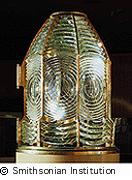| In 1822 a French physicist, Augustin Fresnel,
invented a lens that would make his name commonplace along the seacoasts
of Europe and North America.
This is a first-order Fresnel lens, made in France and shipped to the
United States in the mid-19th century. It consists of concentric
rings of glass prisms that bend the light coming front a lamp inside the
lens into a narrow beam. This lens has 1,176 prisms and 24
bullseyes. At the center, the bullseyes work like a magnilying
glass so that the light beam is even more powerful. The lens
sections are held together by brass frames weighing five to six tons.
The entire lens weighs in at approximately six to eight tons.
 This
type of lens can throw its beam to a distance of 26 miles.
Tests showed that an open flame lost nearly 97% of its light, and a
flame with reflectors behind it still lost 83% of its light. The
Fresnel lens was able to capture all but 17% of its light. This
type of lens can throw its beam to a distance of 26 miles.
Tests showed that an open flame lost nearly 97% of its light, and a
flame with reflectors behind it still lost 83% of its light. The
Fresnel lens was able to capture all but 17% of its light.
At first, an oil lamp with five wicks provided the light source.
Kerosene was the preferred fuel. With the advent of electricity,
lamps came into use. |
|
Augustin Fresnel.
As a child, he was a slow learner who showed little interest in
language studies or in tests of memory. By the age of 8, he could barely
read. Yet his boyhood friends, for whom he studiously determined how to
increase the power of popguns and bows, called him "the
genius." When applied to optics, his genius proved to be real and
considerable. Where others had improved existing lighthouse technology,
Fresnel leapt forward by studying the behavior of light itself. His
studies both advanced the understanding of the nature of light and
produced the most important breakthrough in lighthouse lights in 2,000
years.
Fresnel worked out a number of formulas to calculate the way light
changes direction, or refracts, while passing through glass prisms.
Working with some of the most advanced glassmakers of the day, he
produced a combination of prism shapes that together made up a lens. The
Fresnel lighthouse lens used a large lamp at the focal plane as its
light source. It also contained a central panel of magnifying glasses
surrounded above and below by concentric rings of prisms and mirrors,
all angled to gather light, intensify it and project it outward.
The various reflector systems installed in lighthouses during the 40
years preceding the introduction of the Fresnel lens certainly had been
improvements over the open fires or candles in lantern rooms. Still,
they could trap only a small percentage of the light. All prior systems
paled by comparison with the Fresnel lens.
The first Fresnel lens, installed in the elegant Cardovan Tower
lighthouse on France's Gironde River in 1822, was visible to the
horizon, more than 20 miles away. Sailors had long romanticized
lighthouses. Now scientists could rhapsodize, too. "Nothing can be
more beautiful than an entire apparatus for a fixed light," one
engineer said of Fresnel's device. "I know of no work of art more
beautifully creditable to the boldness, ardor, intelligence, and zeal of
the artist."
Fresnel lenses soon shone along the ragged coastlines of Europe, but
surprisingly, America was slower to see the light. As mariners came to
depend on Europe's powerful new lights, they complained bitterly about
the puny lamps lighting America's coasts.
Despite the clear superiority of Fresnel lenses, the
parsimonious bureaucrat in charge of federal lighthouses, Stephen
Pleasanton, considered the cost prohibitive. Finally, the uproar became
so great that in 1838 Congress launched an investigation. It was not
until then that Congress coughed up the cash to import a few Fresnel
lenses. The first were installed in 1841 inside the two towers at
Navesink Lighthouse, overlooking the approach to New York Harbor.
Only after 1852, when the United States created a Lighthouse Board
made up of eminent scientists and mariners, including Joseph Henry
of the Smithsonian and Alexander Bache of the U.S. Coast Survey, did the
great lenses really begin to light America's coastline. By the Civil
War, nearly all lighthouses in the United States had Fresnel lenses. |